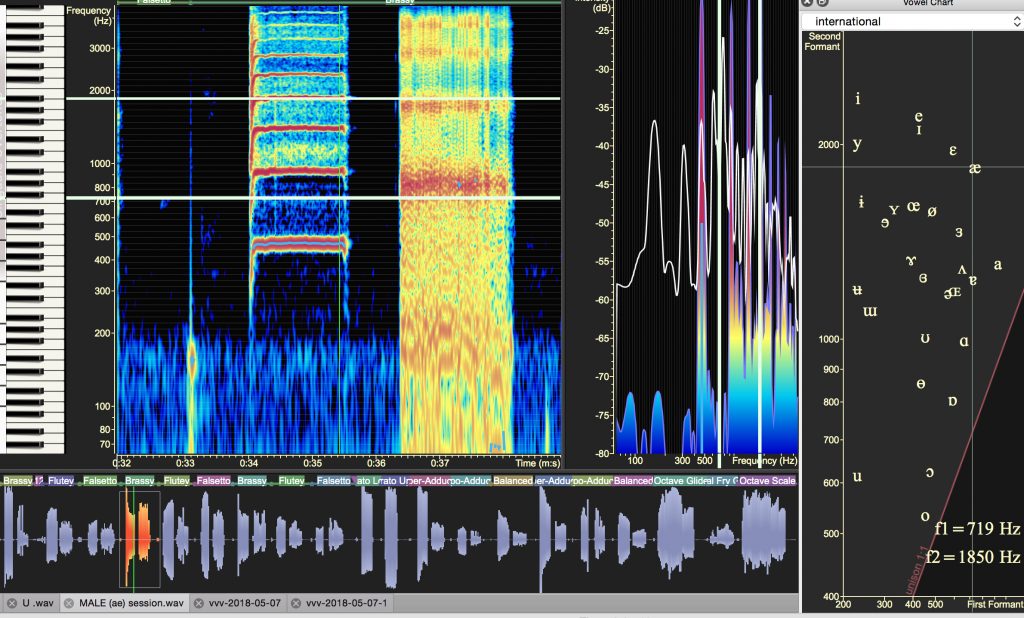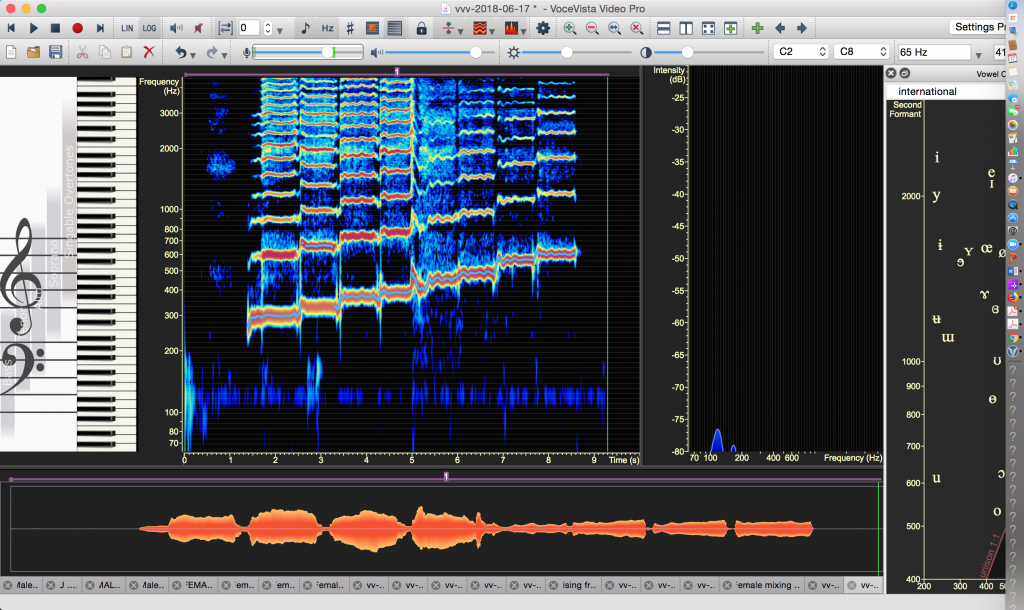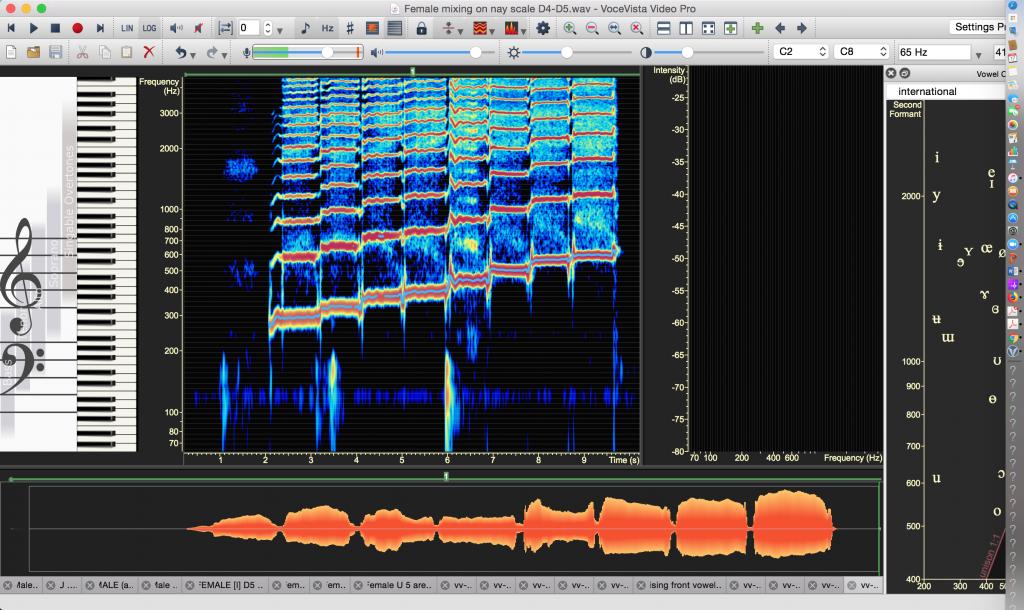The Singer's Formant


THE HIGHER FORMANTS (F3, F4, F5): THE SINGER’S FORMANT CLUSTER
In a spectral analyzer such as Voce Vista, an increase in energy can be seen in some singers in the higher formants F3, F4, F5.
The higher formants can be close together (clustered) or spread. Styles like pop, jazz, and musical theater will show a spreading out of these higher formants F3, F4, F5. This is the mix quality of pop, musical theatre, and other contemporary styles.
Opera, legit musical theater and choral singing show clustering of formants F3, F4, F5. When they cluster, the upper formants only boost selected harmonics, producing the “legit” quality of the classical voice.
In classical singing, F3, F4, and F5 tend to cluster around 2400- 3200 Hz; this increase in energy occurs due to a narrowed epilarynx.
These higher formants, boosting nearby harmonics, give some singers a ringing quality that allows them to be heard over loud accompaniments. In classical singing, this is called the Singer’s Formant. Male tenors in both classical and contemporary singing show this cluster.
Female contemporary singers show it as well; in contemporary singing, this energy boost is called twang.
However, female classical singers rely on an F1/H1 resonance strategy- the whoop or hooty timbre.
Here you can see the bands of energy in F3-F4 when a male pop tenor sings a brassy mix on an open vowel. This is the twang region. The horizontal lines show us F1 and F2 frequencies, also shown in the fuzzy image, where the singer performed a vocal fry on the vowel.
F2 is aligned with and boosting the fourth harmonic. F1 is boosting the second harmonic. The lowest harmonic with the blue line through it is the fundamental frequency (F0) or pitch.

WHAT HAPPENS TO FORMANTS AND HARMONICS WHEN WE SING HIGHER
As long as the pitch is low, the second harmonic is powerful because it is boosted by the first formant. This is the chest voice or lower register. However, when we singer higher pitches, the second harmonic loses power as the H2 frequency becomes higher than the frequency peak of the first formant.
Harmonics are fixed- they are generated at certain intervals above the fundamental, or pitch. When pitch goes up, the harmonic frequencies also become higher.
When H2 frequency reaches the peak of F1 frequency as the pitch rises, it will then “cross over” F1. When the second harmonic passes out of range of F1 it loses power. Now the singer has a problem to fix- they must change the resonance strategy to maintain power!
When we mix, we find harmonics in the range of the second formant, F2, to boost, by tuning the vowels.
When singing ascending pitches, untrained singers often try to hold on to power by raising F1 frequencies via raising the larynx and making the pharynx smaller. This eventually turns into a yell and ultimately produces a flip/crack/break in the voice.
Female tracking H2 with F1
![]()
Female Flip to Falsetto
Notice the interruption of sound in the image above. That is where the break or flip occurred. It’s obvious that this method doesn’t work very well if we want to sing songs with any kind of range.
Instead, those who mix employ a second formant resonance strategy– that is, tuning the second formant to a nearby harmonic. This is acoustic mix.
Mix also involves laryngeal adjustments to balance TA and CT muscle activity. This is the laryngeal mix.
Acoustic adjustments can affect laryngeal adjustments, encouraging the folds to lengthen for higher pitches.
Female mixing on ascending scale n[ei]

Mixing produces an unbroken and even vocal line. In the example above, the singer began the exercise in the short/thick vocal fold phonation and allowed the folds to lengthen as pitch ascended. F1 played a larger role at the beginning of the phrase; F2 was more dominant after the primo passaggio.
If you would like to learn more about your voice AND learn to sing from home for less than you probably spend for lattes every month, check out our amazing YOU can Sing Like a Star online subscription courses for singers and voice teachers.
You can learn to sing with a self-study method- IF it's the right method. The ONLY method that can take you from beginner to professional is the YOU can Sing Like a Star online subscription course with over 600 recorded exercises.
This is the best method available and the ONLY method that takes you all the way from beginner to professional singer- for far less than the cost of in-person voice lessons!
Check this amazing course out at YOU can Sing Like a Star online subscription course.
If you are a voice teacher who wants to up your game, check out the YOU can be a Successful Voice Teacher online subscription course
With over 600 recorded exercises, including Riffs and Runs- Style, you don't need to be a great pianist or vocal stylist to be a great teacher!



